
Coding Concepts in the Primary Math Classroom
by Tara Fulton
In this primary Kindergarten-1st grade STEM lesson, students will learn to define algorithm, bug, and debug in reference to programming. Through engagement with a virtual simulation, students will learn how to use directional arrows to create an algorithm to move an object.
Lesson Plan Link/URL
https://docs.google.com/presentation/d/13W2BdxZXjWeHnH3nwuINjOZsPZllSMai/edit?u…Subject Area
Technology 1. Empowered Learner 5. Computational Thinker Engineering S3: Apply Mathematics to Engineering S5: Apply Technology to Engineering Mathematics Operations and Algebraic Thinking (OA) English Language Arts (ELA) Speaking & Listening
Featured
On
Related Content

Grades:
7th Grade, 8th Grade, 9th Grade, 10th Grade, 11th Grade, 12th Grade
Students will apply principles of design, engineering, and mathematics to create a physical or digital labyrinth inspired by the myth of Theseus. This project integrates STEM concepts with literature

Grades:
4th Grade, 5th Grade, 6th Grade
Students will use Tinkercad's website to create a 3D box and lid. I provide step-by-step Google Slides on how students create this project, share videos of the directions, and additional resources for

Grades:
3rd Grade, 4th Grade, 5th Grade, 6th Grade, 7th Grade, 8th Grade
In this engaging and hands-on lesson, students will be introduced to the fundamental concept of microprocessors, often referred to as the "brains" of electronic devices. Using Micro:bits, a versatile